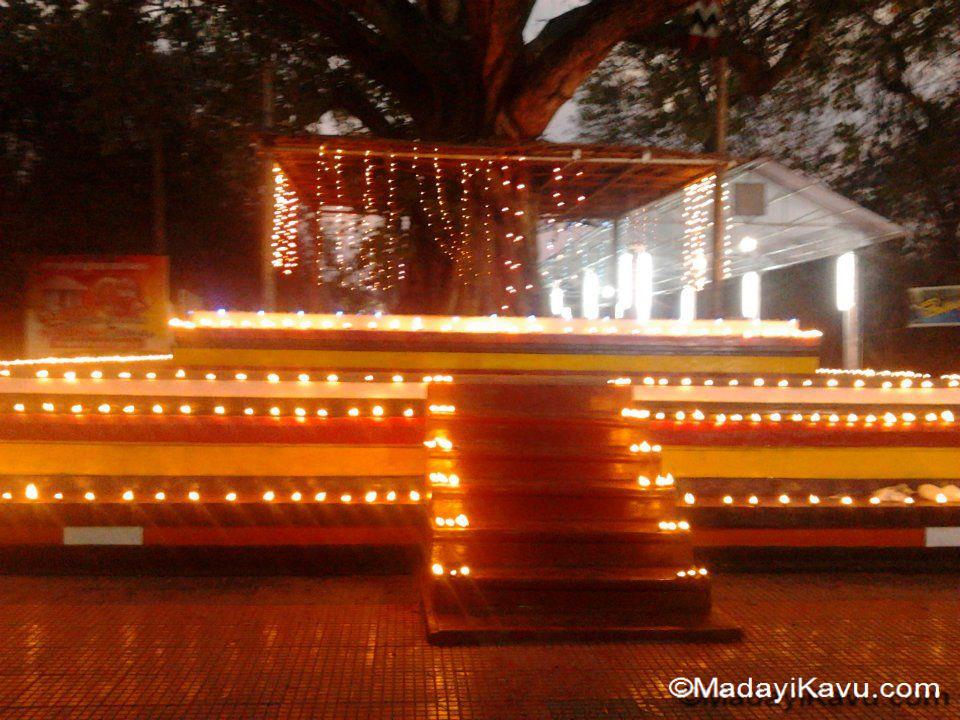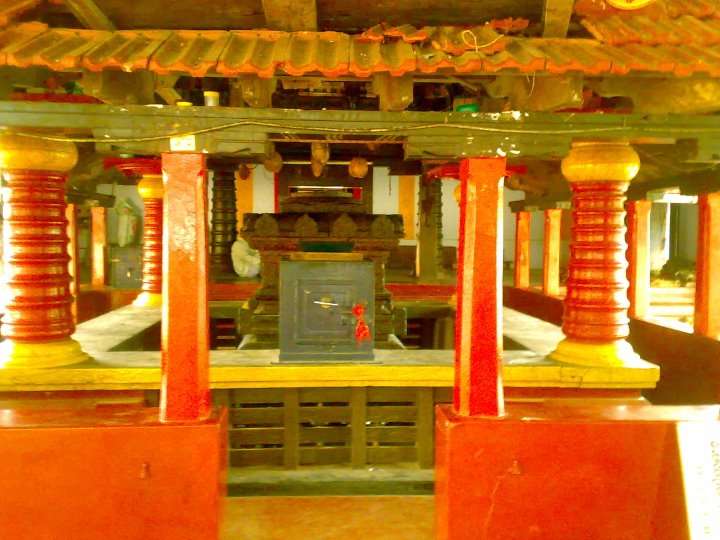Madayikkavu, also known as Thiruvarkadu Bhagavathi Temple, is an ancient and sacred Kaula Shakti shrine situated near Pazhayangadi in Kannur, Kerala.

With a history spanning over two thousand years, the temple has been under the patronage of various regional dynasties, who venerated the presiding deity, Goddess Bhadrakali, as their family deity and undertook several renovations of the sacred grove over the centuries. In modern times, temple upkeep and renovations are carried out by devoted worshippers.
The temple enshrines the fierce and powerful form of Goddess Bhadrakali and is regarded as the 'mother temple' of all Bhadrakali shrines in North Kerala.
This is because many regional temples have consecrated their deities through rituals rooted in Thiruvarkadu, with these deities believed to be manifestations of Madayikkavu Bhagavathi. The temple complex also includes sanctums for Lord Shiva, Saptha Mathrikas (the seven mother goddesses), Lord Ganapathy, Veerabhadra, Kshetrapala (the temple guardian), and Lord Shastha. According to local lore, the shrine is known for its spiritual potency in dispelling negative energies, including black magic and witchcraft. Maadayikavu Temple is situated atop the scenic Maadayippara Hill, a region rich in biodiversity, especially vibrant during the monsoon and spring seasons when a wide array of plants and flowers bloom.
The hill is also a natural habitat for various bird and insect species. However, during the dry summer months, the area is prone to wildfires. The nearby village of Eripuram, whose name translates to ‘Burned Village’, is believed to have been named after such incidents.
Maadayippara is not only ecologically significant but also culturally and historically rich. It houses the Vadukundu Shiva Temple and a temple pond that serves as the main site for the temple's 'Aarattu' ritual bath festival. Another notable feature is the 'Juuda kkulam' or "Jew Pond", which is traditionally linked to ancient Jewish traders who once frequented the region.
This pond remains a vital water source during the arid months. The hill also holds the remnants of an old fort, further underlining its historical importance. Historical records indicate that the site originally began as a simple Kavu (sacred grove), which gradually developed into a full-fledged temple complex through the support and patronage of regional dynasties such as the Mushika, Kolathunad, and Chirakkal, as well as neighboring provinces.
During the British colonial period, a significant event occurred during the construction of a railway bridge over a nearby river. A pillar of the bridge kept collapsing inexplicably until the discovery of a sacred Shankhu (conch shell) at the site.
This prompted local villagers to undertake a major renovation of the temple, which notably coincided with the successful completion of the bridge. Renovation efforts at the temple continue to this day.
Currently, the temple is administered by the Malabar Devaswom Board. It was formerly under the patronage of the Chirakkal Royal Family and was part of the Chirakkal Devaswom. Located in Madayi near Pazhayangadi, the temple is widely known as Madayi Kavu.
Madayi Kavu Temple follows the Tantric architectural style known as Rurujith Vidhanam. In this layout, the sanctum sanctorum of Lord Shiva faces east, while the sanctum of Goddess Bhagavathi faces west and is slightly offset to the southeast. Opposite to Bhagavathi's sanctum lies the Mathrusaala, the shrine of the Saptha Mathrikas—the seven divine mothers: Brahmi, Vaishnavi, Kaumari, Shankari, Varahi, Indrani, and Chamundeshwari. Mathrusaala faces north, aligned towards Shiva’s sanctum. Within it, Lord Ganapathy faces east and Veerabhadra faces west.
The temple also houses a sanctum for Lord Shastha, which faces east, and enshrines the idols of Paathala Bhairavi and Kaala Bhairava.
Traditional worship at Madayi Kavu begins with entering through the eastern gate and following a prescribed path of circumambulation. Devotees first offer prayers to Lord Shastha, then to Kshetrapalakan (the temple guardian), followed by Lord Shiva, the Mathrusaala (Saptha Mathrikas), and finally, to the presiding deity, Goddess Bhagavathi.
The main idol of Bhagavathi at Madayi Kavu is made using the rare and sacred "Kadu Sarkara Yogam" technique—a traditional and esoteric method preserved by select artisan lineages in Kerala. This unique composition, often used for powerful and sacred deities, combines herbal resins, medicinal substances, and other organic materials. Crafted in the 17th century under the guidance of the esteemed Thukalassery Kuzhikkat Maheshwaran Bhattatirippad, this idol remains enshrined within the sanctum and is never moved or exposed to ritual ablutions.
Instead, a separate metal idol is used for rituals such as abhishekam (ritual bathing) and is carried outside the temple during the Aarattu festival procession. This practice safeguards the original deity while upholding the temple's ceremonial traditions. Madayi Kavu temple traditionally celebrated four major annual festivals, but now holds special observances almost every month except during the Malayalam month of Dhanu.
In Karkidakam, the Nira festival is observed; in Chingam, the Puthari festival is celebrated; Kanni features a month-long performance of Chakyar Koothu; Thulam and Makaram each host the Paattu Uthsavam; Kumbham includes the observance of Shiva Rathri; Meenam marks the main annual Pooram or Poora Mahotsavam festival, spanning seven days from Karthika to Pooram Nakshatras, centered around the legend of Goddess Bhagavathi slaying the demon Darika, with the highlight being the symbolic Vaalpayattu ritual using the deity’s Naandakam sword at a site called Daarikan Kotta; Medam features Vishu Vilakku and an 11-day Vishu Pooja; Edavam hosts the Kalasham festival, formerly known as Perum Kaliyattam; and in Midhunam, a one-day ritual called Prathishta Dinam is held, commemorating the deity’s installation.
മാടായിക്കാവ് ഭഗവതി ക്ഷേത്രം
കണ്ണൂർ ജില്ലയിലെ മാടായി ഗ്രാമപഞ്ചായതിൽ സ്ഥിതിചെയ്യുന്ന പ്രശസ്തമായ ഒരു ഭക്തിമന്ദിരമാണ് ശ്രീ മാടായി തിരുവർക്കാട് ഭഗവതി ക്ഷേത്രം, ചുരുക്കത്തിൽ മാടായിക്കാവ് എന്നറിയപ്പെടുന്നു. ആചാരാനുഷ്ഠാനങ്ങളിൽതന്നെ വ്യത്യസ്തത പുലർത്തുന്ന ഈ ക്ഷേത്രം, ഉത്തര മലബാറിലെ ഭദ്രകാളി ക്ഷേത്രങ്ങളുടെ മാതൃകാ ക്ഷേത്രമായി കണക്കാക്കപ്പെടുന്നു. കണ്ണൂരിൽ നിന്നും പഴയങ്ങാടി വഴി പയ്യന്നൂരിലേക്ക് പോകുന്ന വഴിയിൽ എരിപുരത്തിലാണ് ക്ഷേത്രം സ്ഥിതിചെയ്യുന്നത്. സാക്ഷാൽ ആദിപരാശക്തിയായയും ജഗദീശ്വരിയായും ഭാസുരത്വം പകരുന്ന ശ്രീ ഭദ്രകാളിയാണ് ഇവിടുത്തെ പ്രധാന പ്രതിഷ്ഠ. മാടായിക്കാവിലമ്മ, തിരുവർക്കാട്ടമ്മ, അല്ലെങ്കിൽ തിരുവർക്കാട് ഭഗവതി എന്ന പേരുകളിലാണ് ഇവിടുത്തെ ദേവിയെ ശക്തിസ്വരൂപിണിയായി ആരാധിക്കപ്പെടുന്നത്.
ഭഗവതിയോടൊപ്പം സപ്തമാതാക്കൾ ആയ ബ്രാഹ്മി, വൈഷ്ണവി, മഹേശ്വരി, ഇന്ദ്രാണി, വാരാഹി, കൗമാരി, ചാമുണ്ഡി എന്നിവരെയും ഇവിടെ പ്രതിഷ്ഠിച്ചിരിക്കുന്നു. ഭഗവതിക്കൊപ്പം പരമശിവനും പ്രധാന പ്രതിഷ്ഠകളിലൊന്നാണ്, എങ്കിലും ഭഗവതിയെയാണ് ക്ഷേത്രത്തിൽ കൂടുതൽ പ്രധാന്യത്തോടെ ആരാധിക്കുന്നത്. ഗണപതി, ശാസ്താവ് (അയ്യപ്പൻ), ക്ഷേത്രപാലകൻ എന്നിവരാണ് ഇവിടത്തെ ഉപദേവതകൾ. കേരളത്തിലെ ആദ്യത്തെ ഭദ്രകാളി ക്ഷേത്രം കൊടുങ്ങല്ലൂരിലാണെന്ന് പുരാവൃത്തം പറയുന്നു. രണ്ടാമത്തെ ഭദ്രകാളി ക്ഷേത്രം മാടായിയിലാണെന്നും കരുതപ്പെടുന്നു. ഈ രണ്ട് പ്രധാന ക്ഷേത്രങ്ങളിൽനിന്നും ആവാഹിച്ച് കൊണ്ടുപോയി അനേകം ക്ഷേത്രങ്ങൾ കേരളത്തിലുടനീളം പ്രതിഷ്ഠിച്ചിരിക്കുന്നു.
പത്തനംതിട്ടയിലെ പരുമല വലിയ പനയന്നാർക്കാവ് ഭഗവതി ക്ഷേത്രം, തിരുമാന്ധാകുന്ന് ഭഗവതി ക്ഷേത്രം എന്നിവ ഈ ശ്രേണിയിൽപ്പെടുന്നു. ഇവിടെയുള്ള പ്രതിഷ്ഠകൾ രുരുജിത്ത് വിധാനത്തിൽ ആണെന്നും, എല്ലാ ക്ഷേത്രങ്ങളിലും ശിവൻ ഒരു പ്രധാന ദൈവമായും നിലനില്ക്കുന്നു എന്നതും ഒരു അപൂർവതയാണ്.
മാടായിക്കാവിൽ ആരാധിക്കപ്പെടുന്ന ഭഗവതിയാണ് ചിറയ്ക്കൽ കോവിലകത്തിന്റെ കുലദേവതയും കൂടെ.
ഈ ക്ഷേത്രത്തിലെ പ്രസിദ്ധമായ വഴിപാടുകളിൽ പ്രധാനപ്പെട്ടത് ചെറുപയരും കോഴിനിവേദ്യവുമാണ്. പ്രത്യേകിച്ച്, ശാക്തേയ സമ്പ്രദായത്തിൽ പ്രധാനമാക്കിയിരിക്കുന്ന പഞ്ചമകാര പൂജയുടെ ഭാഗമായാണ് കോഴി നിവേദ്യം ഭഗവതിക്ക് സമർപ്പിക്കുന്നത് എന്ന് വിശ്വാസം.
ഈ വിധത്തിലുള്ള നിവേദ്യം മറ്റു ഭദ്രകാളി ക്ഷേത്രങ്ങളിൽ അപൂർവമാണ് എന്നതും മാടായിക്കാവിന്റെ പ്രത്യേകതയായി കണക്കാക്കപ്പെടുന്നു. മാടായി ശ്രീ തിരുവർക്കാട് ഭഗവതി ക്ഷേത്രത്തിൽ രണ്ടു ശ്രീകോവിലുകളുണ്ട്. കൂടാതെ നമസ്കാരമണ്ഡപം, ഉപദേവന്മാരുടെ ക്ഷേത്രങ്ങൾ, ചുറ്റമ്പലം, കലശപ്പുര, കുളം, കിണർ, കാവ് എന്നിവയും ക്ഷേത്രപ്രാകാരത്തിൽ ഉൾക്കൊള്ളുന്നു.
ഇതൊരു അന്യമായ ആചാരക്രമമുള്ള ക്ഷേത്രമാണെന്നും കാണാം. സാധാരണ ക്ഷേത്രങ്ങളിൽ പോലെ അത്താഴപൂജയുടെ നിയമിതരീതിയില്ല. രാത്രി 8.30ഓടെയാണ് നിവേദ്യം ശ്രീകോവിലിൽ വയ്ക്കുന്നത്.
വിശ്വാസപ്രകാരം, അത്താഴപൂജ ദേവന്മാർ തന്നെ ഭഗവതിയെ പൂജിച്ചാണ് പൂർത്തിയാക്കുന്നത്. പിറ്റേന്ന് രാവിലെ, പൂജാരി നട തുറന്ന് ദേവിയുടെ വാൾ എടുത്ത് നമസ്കാരമണ്ഡപത്തിന്റെ വടക്ക്-പടിഞ്ഞാറ് മൂലയിലേക്കാണ് വയ്ക്കുന്നത്. പിന്നീട് അത്താഴ നിവേദ്യം പുറത്തെടുക്കുന്നു.
ക്ഷേത്രത്തിലെ പൂജാരിമാർ "പിടാരർ" എന്നറിയപ്പെടുന്ന ഒറിയ ബ്രാഹ്മണ സമുദായത്തിൽപ്പെട്ടവരാണ്.
ദിവസേന രാവിലെ 4.30 മുതൽ ഉച്ചയ്ക്ക് 12 മണിവരെയും, വൈകിട്ട് 5 മുതൽ 7.30 മണിവരെയും ക്ഷേത്രനട തുറന്നിരിക്കുന്നു.
ചില പ്രത്യേക മാസങ്ങളിലും ചൊവ്വ, വെള്ളി ദിവസങ്ങളിലും അതിരാവിലെ 2 മണിക്ക് നട തുറക്കുന്നതും പതിവാണ്. ചൊവ്വ, വെള്ളി, പൗർണ്ണമി, അമാവാസി, മാസത്തിലെ ആദ്യ തീയതി, നവരാത്രി, ഭഗവതിയുടെ ജന്മനക്ഷത്രദിവസം എന്നിവ ദർശനത്തിന് വിശേഷദിനങ്ങളാണ്.
നവരാത്രിയിലെ വിദ്യാരംഭം, ദീപാവലി, തൃക്കാർത്തിക, തിരുവാതിര, ശിവരാത്രി എന്നിവയും ക്ഷേത്രത്തിലെ പ്രധാന ഉത്സവങ്ങൾക്കിടയിലുമാണ്. ഭഗവതിക്കാവുകളിൽ നടപ്പിലാക്കുന്ന അനുഷ്ഠാനങ്ങളായ കളത്തിലരി, പാട്ട് എന്നിവയും ഈ ക്ഷേത്രത്തിൽ അതിയായ ഭക്തിയോടെ ആചരിക്കുന്നു.
മാടായിക്കാവ് ഭഗവതി ക്ഷേത്രത്തിലെ പ്രധാന വഴിപാട് വഴിയാരടി പൂജയാണ്. പഴക്കമുള്ള വിശ്വാസപ്രകാരം, വസൂരി വന്നപ്പോൾ മാടായിക്കാവിലമ്മയ്ക്ക് കുരുമുളക് നിവേദ്യമിടുന്നത് ഒരുപാട് പ്രചാരത്തിലിരുന്നിരുന്നു. സാധാരണ ഭഗവതി ക്ഷേത്രങ്ങളിൽ നടത്തപ്പെടുന്ന ഭൂരിഭാഗം വഴിപാടുകളും ഈ ക്ഷേത്രത്തിൽ ആചരിക്കാവുന്നതാണ്.
Address:
Madayi Para,
Pazhayangadi, Kerala 670303



